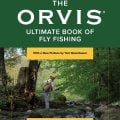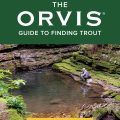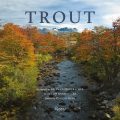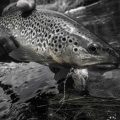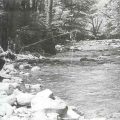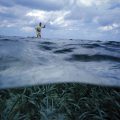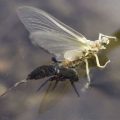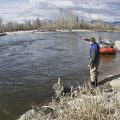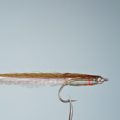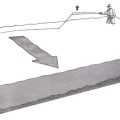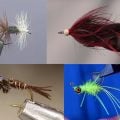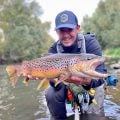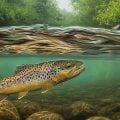Tom Rosenbauer
Tom Rosenbauer has been a fly fisher for over 35 years and was a commercial fly tier by age 14. For 30 years he has been with the Orvis Company, where he is now marketing director for Orvis Rod and Tackle. He has ten fly fishing books in print, including The Orvis Fly-Fishing Guide, Reading Trout Streams, Casting Illusions, Fly-Fishing in America, Approach and Presentation, Trout Foods and Their Imitations, Nymphing Techniques, Leaders, Knots, and Tippets, The Orvis Guide to Dry-Fly Techniques, and The Orvis Fly-Tying Guide, which won a 2001 National Outdoor Book Award. He has also been published in Field & Stream, Outdoor Life, Catalog Age, Fly Fisherman, Sporting Classics, Fly Rod & Reel, Audubon, and other magazines.
Author Articles
Book Excerpt: "The Orvis Ultimate Book of Fly Fishing—Secrets from the Orvis Experts"
The "Orvis Ultimate Book of Fly Fishing" is a grand tour of the world of fly-fishing strategies and techniques, from Orvis's world-famous team of experts and advisors. In large format with rich and helpful color photos and drawings, the book covers everything from basic fishing knots and casts to expert techniques you won't see in standard books. Besides...
Book Excerpt: "The Orvis Guide to Finding Trout"
In fluid mechanics, flow in a liquid is described as either laminar or turbulent (or some consider a transitional state, which is a bit of both). In laminar flow, particles move in smooth paths in layers, with no mixing of adjacent layers. Everything moves independently, like a deck of cards thrown on a table. The velocity, pressure, and other flow...
Book Excerpt: "Trout"
Platitudes. Does fly fishing encourage more of them, or am I just jaded because I have been immersed in fly fishing my entire life? I shouldn’t be hard on people who spout what they feel to be clever revelations, but the following phrases make me grind my teeth and force me to stretch my cheek muscles in what I hope will be an appreciation of novelty...
Reading the Water
SOME WATER that is easily fished during a hatch is tough to blind-fish with consistent success. Stream reading is a vital skill for prospecting, but you should approach a day of fishing with the philosophy that not all places in a stream hold trout, and others that may hold trout cannot be blind-fished easily. When you cast to rising fish, you know exactly...
Rich and Poor Trout Streams
LET ME TELL YOU about a couple of my favorite trout streams. One is Armstrong's Spring Creek, on the O'Hair Ranch in the Paradise Valley of the Yellowstone River in Montana. You stop at the ranch house and pay an obscenely low fee (fifteen dollars in April, thirty during the summer) to fish one of the world's richest little trout streams, in both insect...
"Wading"
When fly fishing in the ocean made a comeback in New England, most of us were wading anglers. I say comeback because despite what fly fishers in the 1970s and 1980s thought, there had been many fly fishers before them in New England waters, back as far as colonial times. But modern tackle, with strong graphite rods and reels with smooth disc drags, made it...
Why an Emerger Is Almost Always a Better Bet Than an Adult
The secret to successfully fishing an insect hatch often boils down to simply fishing an emerger pattern as opposed to a typical dry-fly imitation of an insect with fully formed wings. You’ll often get splashy refusals to your standard dry flies. It may seem like you are not imitating the right insect, but often it’s just that you have not chosen the...
Indicator Fishing with Nymphs
When I was a kid, I used to fish a worm hung below a bobber for sunfish and perch. When I first began, like most kids I just threw it out there and waited until the bobber went under and then yanked like hell. One day I was fishing from a high dock in clear water and was able to watch my worm as it settled under the bobber. I noticed that often the fish...
Tying The Surf Candy
IN A TWIST of fly-tying history, a fly originally developed for the unsophisticated tastes of bluefish became the most effective fly for the wary, sharp-eyedmembers of the tuna family, like bonito, false albacore, and small bluefin tuna. When Bob Popovics came back to Seaside Park, New Jersey, from Vietnam in 1970, no one in his area even knew how to tie a...
When Drag is Desirable
IMPARTING MOVEMENT TO A DRY FLY is one of the most effective and exciting ways to fish dry flies, but it must be done under the right circumstances with special techniques that distinguish movement given to the fly by the fisherman from ordinary drag. Insects on the surface of the water move, no question, but when insects move they do it without creating a...
